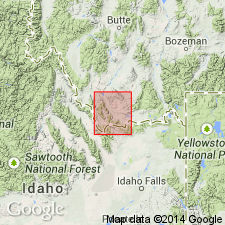
- Usage in publication:
-
- Medicine Lodge beds
- Medicine Lodge volcanics
- Modifications:
-
- Original reference
- Dominant lithology:
-
- Lava
- Tuff
- Shale
- Sandstone
- Conglomerate
- Limestone
- AAPG geologic province:
-
- Montana folded belt
Summary:
Pg. 369-370, table 1, pl. 1. Medicine Lodge beds or Medicine Lodge volcanics. Consists of shales, bentonitic clays, sandstones, pebble conglomerates, fanglomerates, rhyolites, and some lignite; thick vuggy fresh-water limestone at top. Thin- to medium-bedded, cross-bedded, and jointed. White, gray, yellow, violet brown, and brown. Maximum thickness exceeds 5,000 feet. Age is considered Miocene(?).
Type locality not stated. Occupy intermontane basin between Beaverhead and Tendoy Ranges, and a small plateau in Tendoy Range, Clark Co., east-central ID, and Beaverhead Co., southwestern MT.
Source: US geologic names lexicon (USGS Bull. 1200, p. 2445).
For more information, please contact Nancy Stamm, Geologic Names Committee Secretary.
Asterisk (*) indicates published by U.S. Geological Survey authors.
"No current usage" (†) implies that a name has been abandoned or has fallen into disuse. Former usage and, if known, replacement name given in parentheses ( ).
Slash (/) indicates name conflicts with nomenclatural guidelines (CSN, 1933; ACSN, 1961, 1970; NACSN, 1983, 2005, 2021). May be explained within brackets ([ ]).

